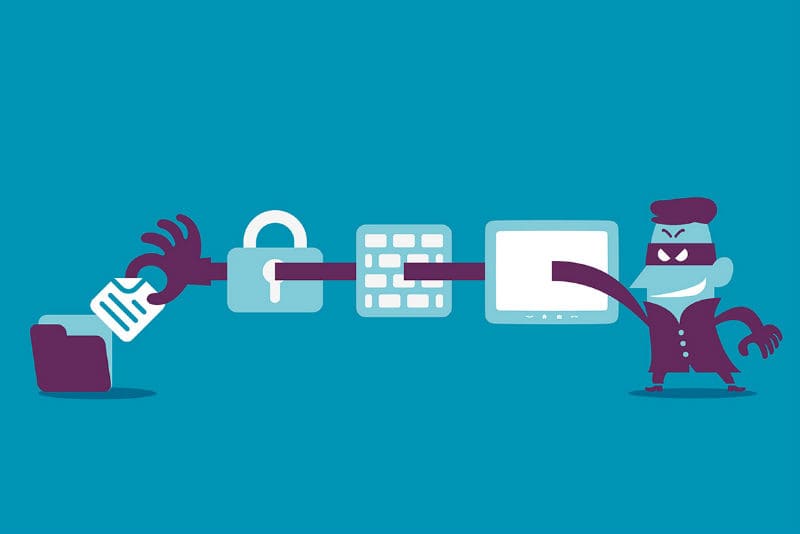Malware is one of the most dangerous threats to your website and can rob you of your critical website information or hamper the functioning of your website!
Table Of Content
What exactly is Malware?
Malware means malicious software that can infect a website with malware, compromising its integrity. In simple words, malware is a software that is created with the purpose of causing harm to data or devices. You might be hearing about Trojans, viruses, spyware etc. these are nothing but several types of malware.
What does Malware do?
The kind of malware you are dealing with can be ascertained with the way in which it causes the damage. Common types of malware are listed below:
– Virus:
Viruses are attached to a clean file and upon accessing, it infects the other clean files. Viruses can spread to a great extent and damage the core functionality of a system and it can also delete and corrupt files. Viruses generally appear in an executable file.
– Trojans:
Trojans disguise themselves as genuine software applications or they may be a part of legitimate software applications that have been tampered. A Trojan functions secretively and creates loops in your website security to let the other form of malware in.
– Spyware:
Just like the name suggests, spyware is a type of malware that is designed to spy on you. Spyware hides in the background and registers what you are doing online and takes notes about critical information like your passwords, your credit card and debit card numbers, what you search online etc.
– Worms:
Worms infect the complete network of local or internet based devices with the use of network interfaces. Worms make use of every consecutive infected machine in order to infect more machines.
– Ransomware:
Ransomware is a rare malware that locks down your computer and threatens to delete everything unless you pay a ransom amount to the creator of the ransomware.
– Adware:
Adware is not always malicious in nature. It is an aggressive advertising software that affects your website security in order to serve you more ads. There are possibilities that these ads might create a pathway for other malware to damage your data and device. Another adverse effect is the creation of pop-ups ads which is really annoying.
– Botnets:
Botnets are basically networks of infected computers that are created to function together under the command of an attacker.
Signs That Your Website Is Potentially Malware Infected
Malware doesn’t always announce itself with a dramatic crash; it hides behind a website’s performance. Hence, it is rare that a website is brought to a complete shutdown with a malware infection. Here are some of the most common ways to tell that your website could be infected with malware:
- Unexpected Redirects: Links included in your website direct users to unrelated or spammy websites that you’ve had no part in.
- Pop-ups and Ads: Uninvited banner advertisements begin appearing alongside content you have not tried to promote or advertise.
- Sudden Traffic Drop: The alarming decline in traffic most often indicates that your website has been blocked or blacklisted by authorities.
- Warnings Within The Browser: Users accessing your site are presented with the common “This Site May Be Hacked” or “Deceptive Site Ahead” notifications from Chrome or Firefox.
- Blacklisting by Google or Antivirus Programs: Your site no longer appears in search queries and also triggers alerts from antivirus software.
- Unfamiliar Files or Plugins: Without your consent, scrapers, unfamiliar folders, and even plugins start showing up within your website’s file manager.
- Slow Performance or Frequent Crashing: Frequent crashing and lagging are linked to server resources being consumed due to an underlying problem. Malware also has a stranglehold on your server.
7 Great Tips to Protect Your Website from Malware
Malware is surely a dangerous thing! Here are 7 great tips you can use to protect your website:
– Updating Software And CMS
Most of the website owners prefer to work with a content management system like WordPress, Joomla or Drupal etc. A CMS is easy to use and affordable, but to protect website from malware, you must keep it updated. If the CMS is not updated in time, it can create a pathway for cyberattacks. New updates are created for content management systems and software to provide a higher level of security and offer valuable malware protection tips. It is important to make sure that your system, plugins, themes, extensions, and CMS version are updated in time to enable website malware prevention. Popular content management systems like WordPress will notify you when a new update is ready to be implemented or if you schedule automatic updates, it will also update in time by itself.
– Website Scanning
Many types of malware and viruses go unnoticed, even on a website with malware, because owners aren’t aware of them. Malware and viruses can be implemented with a single one-line script, underscoring the need for malware protection tips in your dev toolkit. This malicious code is made to look like the normal website code. To prevent this, choose web hosting with malware protection that offers website scanning. Although this is a paid service, investing in web hosting with malware protection safeguards your site from malicious code. Website scanning looks for harmful code that does not belong to the code of your website and the malicious code is immediately notified.
– Web Application Firewalls
It is not just important to tackle the existing website threats, it is also important to prevent them from coming back. Web application firewalls (WAF) play a key role in malware protection tips, preventing attackers from visiting your site. A web application firewall analyzes and identifies a website with malware threats, blocking malicious actors. It also analyses the behavior of the website traffic and the type of information requested. Based on these factors and some other important criteria, the firewall allows the legitimate traffic like customers and search engines to access your website and blocks the malicious traffic like hackers and spam bots.
– Strong Passwords
You might have heard that it is important to use strong and complicated passwords that are hard to guess, but have you implemented it? If you haven’t, then you must change your passwords right away. An approximate definition of a strong password is a password that comprises of more than eight characters, no dictionary words, a mix of uppercase and lowercase letters, use of digits and special characters. A weak password can provide a pathway to the hackers to create a brute-force attack on your website. It is important to create a strong password as part of your malware protection tips, making brute-force attacks difficult. If you have customers creating accounts on your website, advise them to use strong and complicated passwords as well.
– Use of HTTPS
As a customer you might be looking for the green HTTPS bar while shopping online or while making an online payment. The green bar and HTTPS in the URL of the website states that the website is secured with a Secure Sockets Layer (SSL). Having an SSL certificate installed on your website is a great way of enhancing security and safeguarding the customer transactions. With SSL, all transactions on your site are authenticated, which is an essential step in website malware prevention. Therefore, it is difficult for hackers to put any virus or malicious code on your website. Having an SSL certificate installed on your website not just secures your website but also provides you with search engine benefit as Google prefers the website that use SSL certificate.
– Conceal Your ‘Admin’ Directories
One of the easiest ways that hackers use to access your website’s data is by accessing the ‘Admin’ directories. Hackers make use of scripts that can scan the directories on your web server to look for names like ‘admin’, ‘loigin’, ‘access’ etc. and after locating such files, hackers start making attempts to comprise the website security. Most of the web hosting platforms provide control over your website directory names and you can rename your admin folders to something else so that they are not easily found by the hackers. Select directory names that would not signify admin directories and notify the other webmasters working on your website about this. This practice will enable you to ward off a major security breach.
– Use Of MalwareGone Software
MalwareGone is a great software that detects the malware and provides solutions for getting rid of it. MalwareGone uses actionable intelligence to support malware protection hosting, analyzing site data effectively. This method allows the scanner to detect files that act and look like malware. This software is crafted to discover viruses, rootkits, trojans, spyware and other types of malware on a website. MalwareGone detects and removes the constant threats from your operating system by making use of prior backups that are stored in a cloud environment.
Free vs. Paid Malware Scanners: Which One Should You Use?
Security tools are split into two categories—free and premium. Scanners based on malware, along with other security tools, such as website firewalls, fall into these categories. Here’s a side-by-side comparison to help you make the right call:
| Feature | Free Tools | Paid Tools (e.g., MilesWeb add-on) |
| Basic Malware Detection | Yes | Yes |
| Real-time Monitoring | No | Yes |
| Automatic Malware Removal | Manual Cleanup Required | Included |
| Blacklist Monitoring & Removal | Limited or None | Included |
| Web Application Firewall (WAF) | Not Included | Included |
| Advanced Threat Protection | No | Yes |
| Performance Optimization | No | Often included |
| Support | Community-Based | Expert Support |
For websites of any size, malware attacks are now an undeniable reality. Attackers continue to target sites of all natures, and if there is no universal solution to such issues, applying website security measures thoroughly makes a strong difference.
With expert security support, MilesWeb offers web hosting solutions equipped with built-in protection against malware and daily backups. Protect your website effortlessly with 24/7 support on standby.
FAQs:
What is the single most effective thing I can do to protect against malware?
To protect against malware, software, especially the operating system, CMS, plugins, and antivirus tools, needs to be maintained and updated regularly. Regular software updates, backup reimbursements, and trustworthy hosting with malware protection guarantee that websites are comprehensive and reduce the risks of vulnerability being exposed by cybercriminals.
How can I protect myself from phishing emails that deliver malware?
To protect against phishing emails, avoid unfamiliar links and refrain from downloading unsolicited attachments. Email filters, along with antivirus applications, are a good line of defense, along with manually verifying URLs before logging in to any site. You and your team should be educated on fake domains and phony urgent messaging designed to disguise malware.
What is multi-factor authentication (MFA), and how does it help?
Multi-factor authentication (MFA) allows users to provide multiple forms of verification to confirm their identity, such as a password along with a one-time code sent to their phone. It prevents unauthorized access and protects user data even if a password is compromised.
What are the common signs that my computer might be infected with malware?
Being suddenly slower than your usual speed, unexpected pop-ups, being redirected to unknown webpages, or crashing frequently could be signs of a malware infection. Additionally, disabled antivirus programs, unrequested new apps, being unable to access security software, and blocked access to security sites are other warning signs.















